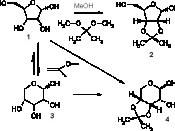Carbohydrates are any of a large group of compounds in which hydrogen and oxygen, in the proportions in which they exist in water, are combined with carbon. Carbohydrates as a class are the most abundant organic compounds found in nature. They are produced by green plants and by bacteria using the process known as photosynthesis, in which carbon dioxide is taken from the air by means of solar energy to yield the carbohydrates as well as all the other chemicals needed by the organisms to survive and grow. The carbohydrate group consists principally of sugar, starch, dextrin, cellulose, and glycogen, substances that constitute an important part of the human diet and that of many animals. The simplest of them are the simple sugars, or monosaccharides, which contain either an aldehyde or a ketone group. The most important is glucose.
Two monosaccharide molecules joined together by an oxygen atom, with the elimination of a molecule of water, yield a disaccharide, of which the most important are sucrose (ordinary cane sugar), lactose, and maltose.
Within living organisms, carbohydrates serve both essential structural and energy-storage functions. In plants, cellulose and hemicellulose are the main structural elements. In invertebrate animals, the polysaccharide chitin is the main component of the exoskeletons of arthropods. In vertebrate animals, the cell coatings of connective tissues contain carbohydrates. Plants use starch and animals use glycogen to store energy; when the energy is needed, the carbohydrates are broken down by enzymes.
Carbohydrates are used in the manufacture of fabrics, photographic film, plastics, and other products. Cellulose, a carbohydrate, can be converted into viscose rayon, acetate rayon, and paper products. Nitrocellulose is used in the production of motion picture film, cement, guncotton, celluloid, and similar kinds of plastics. Starch is used in the preparation of foods for livestock and humans;...


